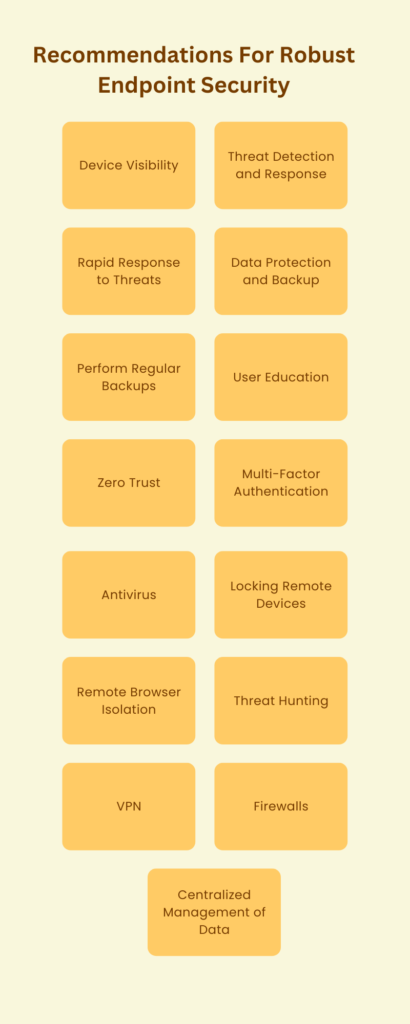
Introduction
With the shift to remote work comes heightened cybersecurity challenges, particularly concerning endpoint security. As employees log in from various locations, the potential for cyber threats multiplies. Securing endpoints is paramount. It’s not just about protecting company data; it’s about ensuring that every device connecting to your network remains a fortress against cyberattacks. As we delve deeper into this topic, we’ll uncover the essential steps every small business manager should take to fortify their digital defenses in this new era of work.
What is Endpoint Security?
Endpoint security is a comprehensive approach to protect your business’s digital assets from potential threats. In the context of remote work, it ensures that every device connecting to the network is secure and free from vulnerabilities.

Key Recommendations for Robust Endpoint Security
1. Clear Visibility of All Devices
Knowing each device aids immensely in securing remote endpoints. When you’re aware of all devices, you can ensure they meet security standards before granting access. This proactive approach minimizes vulnerabilities. Moreover, visibility allows for quicker response times in case of security breaches.
2. Threat Detection and Response
Endpoint security for remote work is not just about prevention; it’s equally about detection and response. Relying solely on preventive measures is no longer sufficient. Small business managers must understand the significance of proactive threat detection and the role of rapid response in minimizing potential damage.
Proactive threat detection involves actively seeking out potential threats before they manifest into full-blown attacks. This approach allows businesses to identify and mitigate risks in their infancy. Let’s delve into a few use cases to understand its importance better:
- Use Case 1: Phishing Attack on an Employee
Proactive threat detection tools would identify the malicious nature of this email based on its patterns. Then, it can block it before reaching the employee’s inbox. - Use Case 2: Malware from a Compromised Software Update
Proactive detection would recognize the irregularities in the update file and halt its installation, safeguarding the company’s digital assets. - Use Case 3: Unauthorized Device Access
With proactive detection, the system identifies unauthorized attempts and blocks them, preventing potential data theft or other malicious activities.
3. Rapid Response: The Key to Minimizing Damage
The speed of your response determines the damage once you detect a threat. Rapid response mechanisms identify and neutralize threats swiftly.
- Example 1: Ransomware Attack
A rapid response would isolate the affected systems, preventing the spread of ransomware. - Example 2: Insider Threat
A rapid response system would detect unusual data transfers and halt them immediately, safeguarding the company’s intellectual property. - Example 3: DDoS Attack
A Distributed Denial of Service (DDoS) attack aims to overwhelm a company’s online services. Rapid response would involve diverting traffic, filtering out malicious requests, and ensuring the company’s online services remain operational.
4. Data Protection and Backup
Understanding the intricacies of data protection and the significance of regular backups is crucial. Not only does this safeguard the company’s sensitive information, but it also ensures business continuity in the face of unforeseen challenges.
Sensitive data, be it customer information, financial records, or proprietary research, is the lifeblood of many businesses. Protecting this data is not just a matter of compliance but a necessity for maintaining trust and reputation.
- Example 1: Customer Information Leak
Imagine a scenario where a company’s customer database is exposed due to inadequate data protection measures. Addressing such vulnerabilities proactively is essential, as highlighted in our guide on why data security is important to a business. - Example 2: Intellectual Property Theft
A competitor gaining access to a company’s research and development data due to weak data protection protocols could lead to significant financial losses and a potential loss of competitive advantage. - Example 3: Financial Data Exposure
A company’s financial records becoming public can lead to reputational damage, stock price drops, and potential legal ramifications.
5. The Role of Regular Backups in Data Security
Backups play a pivotal role in data security. They ensure that even in the event of data loss or corruption, a recent copy is available to restore normalcy.
- Example 1: Ransomware Attack
A company’s data gets encrypted by ransomware, with attackers demanding a hefty ransom for decryption. If the company had regular backups, they could restore their data without paying the ransom, minimizing downtime and financial loss. - Example 2: Accidental Deletion
An employee accidentally deletes a critical project file. With regular backups, this file can be quickly retrieved. - Example 3: Hardware Failure
A server crashes, leading to potential data loss. Regular backups ensure that the data can be restored on a new server.
6. User Education and Awareness
Endpoint security for remote work isn’t solely about implementing the right tools and technologies. A significant aspect of it revolves around user education and awareness. After all, the most advanced security systems can be rendered ineffective if users unknowingly engage in risky behaviors.
The Threat of Phishing Attacks and Other Security Risks
Phishing attacks, where cybercriminals attempt to deceive users into revealing sensitive information, are among the most prevalent threats today.
- Example 1: Regular Training Sessions
Conducting regular training sessions that simulate phishing scenarios can be effective. Expose employees to mock phishing emails. - Example 2: Informative Posters and Emails
Distributing informative posters or emails highlighting the characteristics of phishing emails. - Example 3: Awareness of Smishing
Educating users about the dangers of clicking on suspicious links in text messages or sharing personal information can prevent potential breaches.
Training Remote Workers to Recognize and Avoid Threats
With the rise of remote work, the need for employees to recognize and report potential threats has never been greater.
- Example 1: Suspicious Email Attachments
A remote worker receives an email with an unexpected attachment. Because of prior training, they recognize this as a potential threat. - Example 2: Unfamiliar Software Update Prompts
An employee encounters a sudden prompt to update software. They recognize this as a potential malware delivery method, avoid the update, and notify their superiors. - Example 3: Unexpected Account Activity Alerts
An employee receives an email about unauthorized activity on a company account. Instead of clicking on the provided link, they access the account directly through the official website.
7. Implementing Zero Trust
Zero Trust is a security model that operates on a simple yet powerful premise: trust nothing, verify everything.
Zero Trust requires continuous verification of identity and permissions, irrespective of where the access request originates. This approach is essential for endpoint protection, especially with the increasing number of devices accessing corporate data from varied locations.
Minimizing Risks with Zero Trust
The beauty of the Zero Trust model lies in its ability to minimize risks. This is true even if an attacker manages to breach the initial defenses. Here’s how:
- Scenario 1: Compromised Employee Credentials
An attacker gains access to an employee’s login details through a phishing attack. However, with Zero Trust in place, merely having the credentials isn’t enough. The attacker would also need to pass additional verification checks, such as multi-factor authentication. - Scenario 2: Malicious Insider Threat
An employee with malicious intent tries to access data outside their designated permissions. With Zero Trust, every access request is treated with suspicion, regardless of its source. - Scenario 3: Infected Device Connecting to the Network
A device infected with malware tries to connect to the company’s network. Zero Trust policies would require the device to undergo rigorous checks before granting access.
8. MFA (Multi-Factor Authentication) on Login
MFA is a security mechanism that requires users to provide multiple forms of identification before granting access. Instead of just relying on a password, MFA adds additional layers of verification, making unauthorized access significantly more challenging.
- Example 1: Biometric Verification
Along with entering a password, a user might be required to verify their identity using a fingerprint or facial recognition. - Example 2: One-Time Passcodes (OTP)
After entering a password, a user receives a one-time passcode on their registered mobile device. This code, valid for only a short duration, needs to be entered to gain access.
9. Antivirus Software: A Must-Have Security Tool
In the vast realm of endpoint security, antivirus software stands as a foundational pillar. Understanding its significance and ensuring its deployment across all devices is crucial. Let’s delve into the role of antivirus in safeguarding your digital assets. Let’s see why it’s an indispensable tool in today’s cyber-threat landscape.
The Role of Antivirus in Protecting Against Threats
Antivirus software is designed to detect, prevent, and remove malicious software, ensuring that your devices and data remain uncompromised.
- Example 1: Real-time Malware Detection
An employee downloads a seemingly harmless document from an email. Unknown to them, it contains hidden malware. Antivirus software has real-time scanning capabilities that would identify and quarantine the malicious file. - Example 2: Protection Against Phishing Websites
An employee clicks on a link that leads to a website designed to steal login credentials. Modern antivirus solutions not only protect against malicious files but also against harmful websites. - Example 3: System Health Checks
Regular system scans by antivirus software can detect dormant threats or system vulnerabilities. Thus, ensuring that potential risks are addressed before they manifest into bigger problems.
10. Locking Remote Devices Using Passwords
For devices used in remote work scenarios, the first line of defense is often a strong, unique password. Small business managers must emphasize the importance of this basic yet crucial security measure to their teams.
Imagine an employee working from a café. Then, momentarily stepping away and leaving their laptop unattended. With a strong password in place, the data remains protected.
Even if the device is stolen, the thief would find it challenging to bypass a robust password.
11. Remote Browser Isolation
Remote Browser Isolation is a technology that separates a user’s browsing activity from their local machine and network. Instead of directly loading web content on a user’s device, RBI renders the content in a remote, isolated environment.
- Example 1: Malicious Web Content
An employee visits a website that contains malicious scripts. With RBI, these scripts execute in the isolated environment. - Example 2: Phishing Websites
A user accidentally clicks on a link to a phishing website. RBI ensures that any malicious content or data-stealing scripts on that site remain isolated. - Example 3: Downloading Infected Files
While downloading a file, RBI can scan and ensure it’s free from malware before it reaches the user’s device.
By isolating browsing activities, RBI minimizes the chances of exploitation, thereby reducing the attack surface.
12. Threat Hunting Software: Proactive Defense
Threat hunting involves actively searching for signs of malicious activity within your systems. This includes activity that may have gone unnoticed by traditional security tools. It’s about taking the initiative, rather than waiting for alerts.
- Example 1: Unusual Network Traffic
Traditional security tools might flag a massive data breach, but subtle, unusual network traffic patterns might go unnoticed. Threat hunting proactively identifies these anomalies, potentially catching a cybercriminal in the early stages of an attack. Dive deeper into the process with our guide on how to do threat hunting. - Example 2: Insider Threats
While traditional tools often focus on external threats, threat hunting delves into activities within the organization. This means identifying potentially harmful actions by employees or contractors, ensuring that threats from within are also addressed. - Example 3: Integration with Endpoint Detection
Threat hunting doesn’t operate in isolation. It integrates with endpoint detection and response tools. Thus, ensuring a comprehensive view of potential vulnerabilities and providing a multi-faceted defense strategy.
In conclusion, threat hunting is not just another tool in the cybersecurity arsenal; it’s a mindset. It’s about being proactive, always staying a step ahead of potential threats, and ensuring that your business’s digital assets remain uncompromised. Investing in threat hunting software and practices is a forward-thinking move. Thus, ensuring robust endpoint security in an increasingly complex digital landscape.
13. VPN (Virtual Private Networks): Securing the Connection
A VPN acts as a secure tunnel between a user’s device and the network they’re trying to access. A VPN ensures that the connection remains private and secure from potential eavesdroppers.
One of the standout features of a VPN is its ability to encrypt data. This means that any information sent or received while connected to a VPN is scrambled. Furthermore, a VPN hides user activity, ensuring that online actions remain anonymous and shielded from prying eyes.
For instance, consider an employee accessing sensitive company data from a public Wi-Fi network. Without a VPN, this data could be intercepted and stolen by malicious actors. But with a VPN, the data is encrypted. That ensures that even if someone were to intercept it, they wouldn’t be able to understand or use it.
14. Firewall Solutions: The Gatekeeper
A firewall, at its core, filters incoming and outgoing traffic to and from a network. It acts as a gatekeeper, allowing legitimate traffic to pass through while blocking malicious or unwanted data packets.
- Example 1: Blocking Malicious Websites
An employee unknowingly clicks on a link leading to a malicious website. The firewall detects the harmful nature of the site and blocks access. - Example 2: Preventing Unauthorized Access
A cybercriminal attempts to access the company’s internal systems. The firewall identifies the unauthorized attempt and immediately denies access. - Example 3: Filtering Spam and Malware
Firewalls can detect and filter out spam emails or emails containing malware. - Example 4: Application Control
A firewall can be configured to allow or deny specific applications from accessing the internet. - Example 5: Monitoring Traffic Patterns
A firewall can detect unusual activity. Such activity might indicate a data breach attempt.
15. Centralized and Integrated Endpoint Management Tool
Managing and securing every endpoint individually can be a daunting task. Enter the Centralized and Integrated Endpoint Management Tool, a solution designed to streamline this process.
- Unified Management is Efficient
Imagine having to individually update or patch each device in your organization. A unified management tool ensures that all endpoints are updated simultaneously, ensuring consistency and reducing potential vulnerabilities through a centralized console. - Simplifying Device Monitoring
With a centralized tool, monitoring device activity becomes a breeze. Managers can get a holistic view of all endpoint activities from a single dashboard.
For instance, if an unauthorized software installation occurs on a device, the tool can immediately flag it. - Consistent Security Controls
Implementing security controls on each device separately can lead to inconsistencies. A centralized tool ensures that all devices adhere to the same security standards.
Conclusion
The significance of robust endpoint security cannot be overstated. Every device that connects to your network represents a potential entry point for cyber threats. We’ve explored specific recommendations like VPNs, firewalls, and centralized management tools. From there, there’s a comprehensive toolkit available to fortify your digital defenses.
The responsibility is clear: prioritize and implement these recommendations to safeguard your company’s data, assets, and reputation. In a world filled with evolving threats, proactive endpoint security isn’t just a recommendation—it’s a necessity. Secure today to thrive tomorrow.
Take Action Now!
Don’t wait for a security breach to realize the importance of robust endpoint protection. Assess your current measures and take proactive steps to fortify your defenses. Here’s a quick action plan to get you started:
- Evaluate Your Current Security: Review your existing endpoint security solutions. Are they up-to-date? Do they cover all devices, including mobile ones?
- Educate Your Team: Ensure that every team member understands the importance of security. Host regular training sessions on best practices and the latest threats.
- Implement Multi-Layered Defense: Don’t rely on just one solution. Combine firewalls, VPNs, threat hunting software, and more for comprehensive protection.
- Regularly Update & Patch: Cyber threats evolve constantly. Regularly update your software and systems to patch any vulnerabilities.
- Seek Expert Advice: Consider consulting with cybersecurity experts or firms to get a thorough assessment of your security posture.
Remember, in the realm of cybersecurity, complacency can be costly. Take action today to ensure a safer, more secure tomorrow for your business.

Experienced cybersecurity analyst, software engineer, patent attorney, worked with Linux, Windows, AWS, lots of security tools. Hope to help people do the right things and do the things right!


